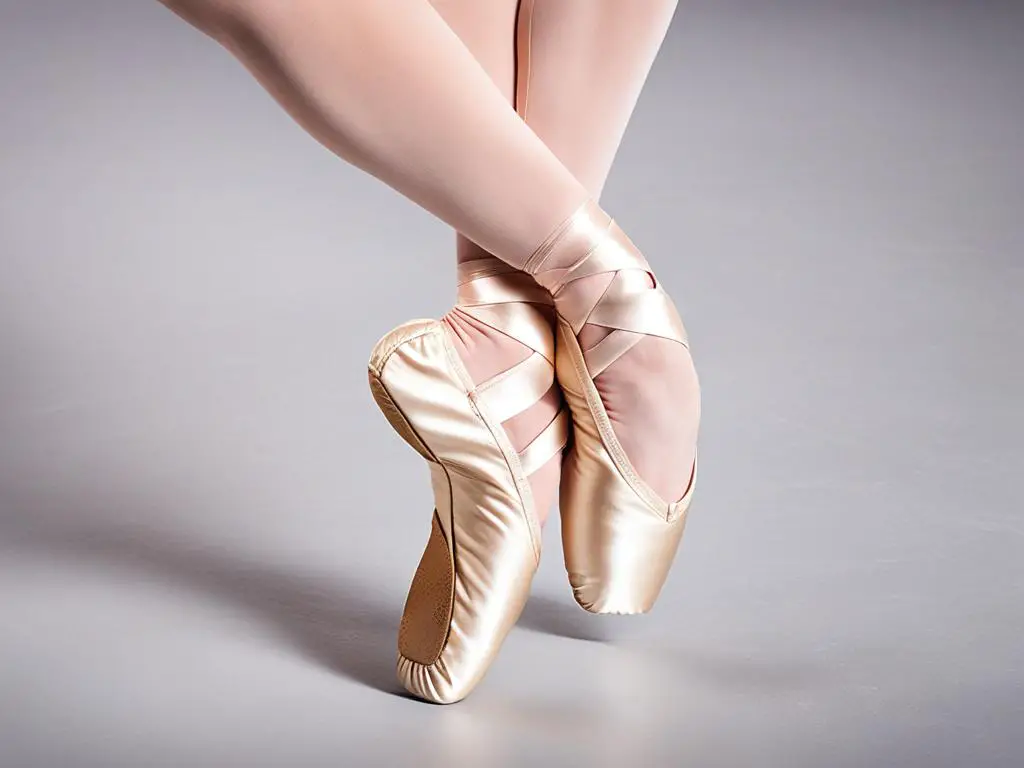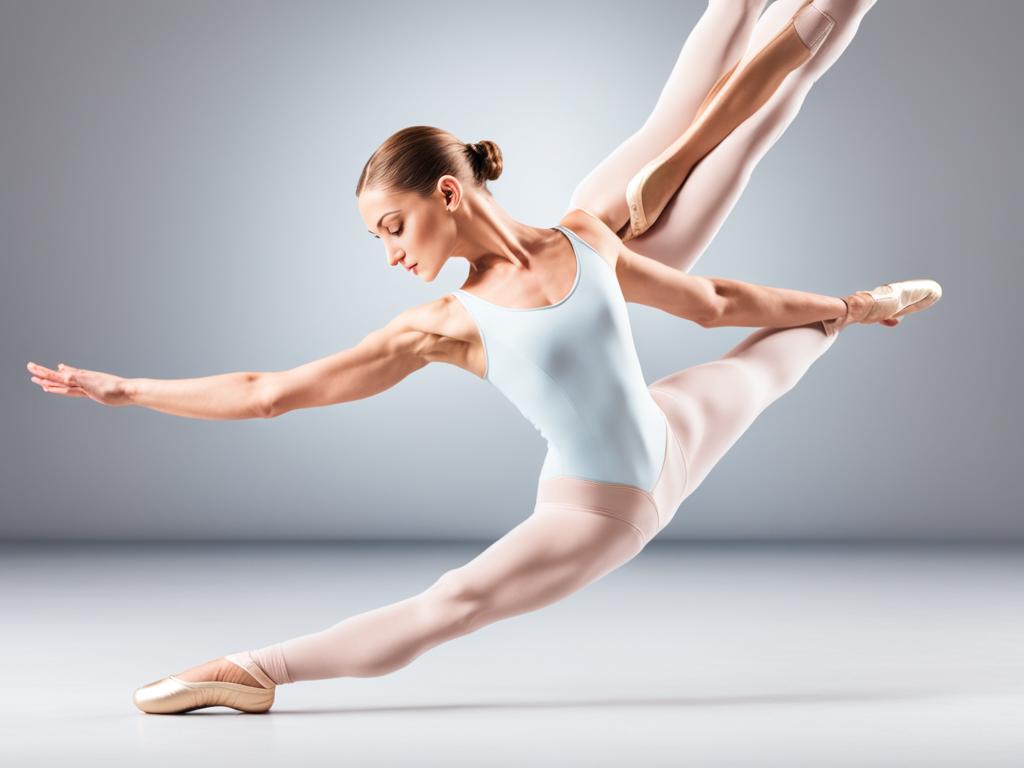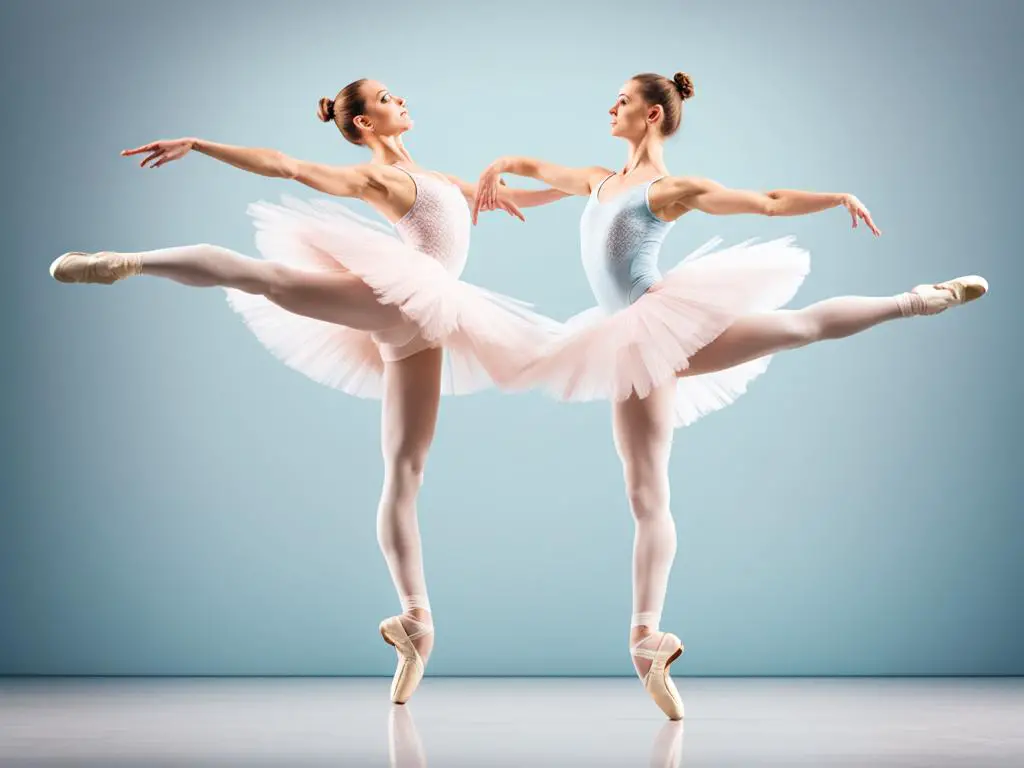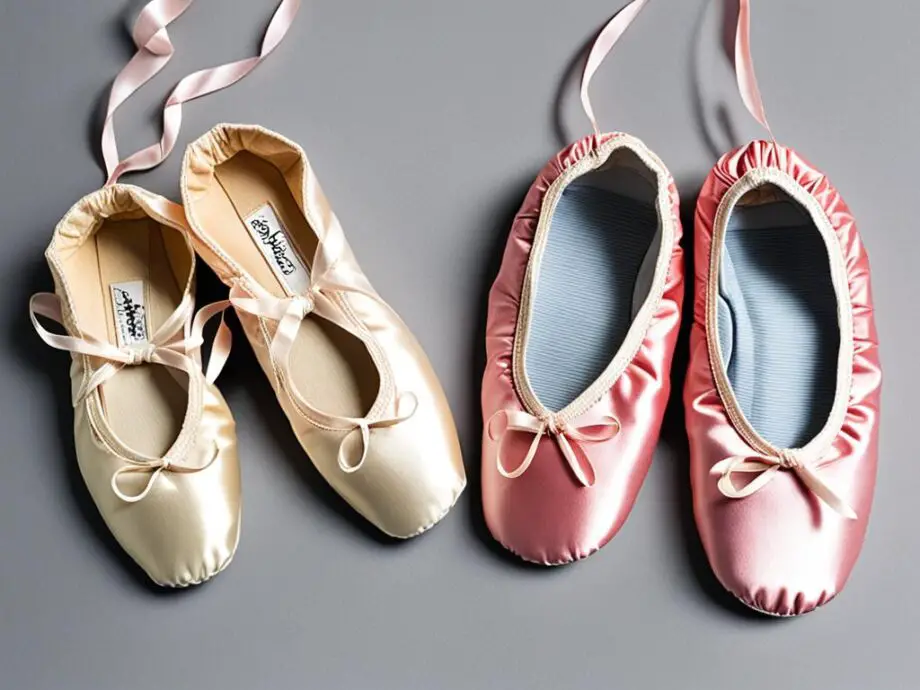Welcome to our guide on split sole vs full sole ballet shoes! If you’re a ballet dancer or considering taking up ballet, you’ve probably come across these terms. In this guide, we will explore the differences between split sole and full sole ballet shoes, so you can make an informed decision about which type of shoe is best for you.
Key Takeaways:
- Split sole ballet shoes have a divided sole, offering greater flexibility and highlighting the foot’s arch.
- Full sole ballet shoes have a sole that extends throughout the whole foot, providing stability and support.
- Split sole shoes are ideal for advanced dancers, while full sole shoes are suitable for beginners or those who require more foot strength.
- Consider your individual needs and dancing goals when choosing between split sole and full sole ballet shoes.
- Try on different brands and styles to find the perfect fit for your feet.
Understanding Split Sole Ballet Shoes
Split sole ballet shoes are a popular choice among dancers due to their numerous advantages and benefits. Unlike full sole ballet shoes, split sole shoes feature a design with the sole divided into two sections – one for the ball of the foot and one for the heel.
This unique design offers several key advantages:
- Enhanced Flexibility and Articulation: The division of the sole allows the foot to bend and point more easily, providing greater flexibility and improved range of motion. Dancers can execute complex movements with precision and grace, showcasing their artistic expression on the dance floor.
- Closer Connection to the Floor: Split sole ballet shoes create a closer connection between the dancer’s foot and the floor. This close contact enhances balance, control, and technique, allowing for seamless transitions and fluid movements. The reduced sole material also provides a lighter and more responsive feel.
- Highlighting the Foot’s Arch: The split sole design helps to accentuate the arch of the foot, creating a visually pleasing line. This aesthetic aspect is particularly important in ballet, where the overall presentation and elegance of the dancer’s feet play a significant role.
For a visual representation of split sole ballet shoes, take a look at the image below:
With their flexibility, improved connection to the floor, and aesthetic appeal, split sole ballet shoes offer dancers a footwear option that enhances their performance and elevates their skill level. In the next section, we’ll explore the characteristics of full sole ballet shoes to provide a comprehensive comparison.
Exploring Full Sole Ballet Shoes
When it comes to ballet shoes, there are two main options: split sole and full sole. In the previous section, we delved into the advantages of split sole ballet shoes. Now, let’s take a closer look at full sole ballet shoes and the differences they offer.
Full sole ballet shoes have a sole that extends the entire length of the foot, providing support from the ball to the heel. This design offers more stability and can be especially beneficial for beginners or dancers with weaker feet. The full sole distributes the weight evenly, giving a solid base for jumps, turns, and other movements.
Although full sole ballet shoes may not offer the same level of flexibility as split sole shoes, they still allow for proper foot articulation. The construction of the shoe ensures that the foot can move and bend as needed during various ballet techniques. Over time, wearing full sole shoes can strengthen the foot and improve overall foot strength.
Benefits of Full Sole Ballet Shoes:
- Enhanced stability
- Support for weaker feet
- Proper foot articulation
- Improved foot strength
“Full sole ballet shoes are like a reliable foundation. They provide the stability and support beginner dancers need to build their skills.” – Julia Martinez, professional ballet dancer
While full sole ballet shoes may not offer the same level of flexibility as split sole shoes, they have their own unique benefits. The choice between full sole and split sole ultimately depends on your dancing style, level of experience, and personal preferences. It’s important to try both types of shoes and see which one feels most comfortable and supportive for your individual needs.
Comparison of Full Sole and Split Sole Ballet Shoes
| Full Sole Ballet Shoes | Split Sole Ballet Shoes |
|---|---|
| Provide stability and support | Offer greater flexibility |
| Distribute weight evenly | Allow for closer connection to the floor |
| Beneficial for beginners and weaker feet | Highlight the arch of the foot |
| Improve overall foot strength | Enhance foot articulation |

As you can see, both full sole and split sole ballet shoes have their own advantages. It’s essential to consider your specific needs and goals when choosing the right ballet shoe for you. Whether you opt for full sole or split sole, finding a shoe that fits well and supports your dancing endeavors is key.
Comparing Performance and Flexibility
When it comes to performance and flexibility, both split sole and full sole ballet shoes have their advantages. Split sole shoes excel in allowing for greater range of motion and highlighting the arch. They are ideal for more advanced dancers who have developed strong foot muscles and need the utmost flexibility. On the other hand, full sole shoes provide stability and support, making them suitable for beginners or those who require additional foot strength.
Ultimately, the choice between split sole and full sole shoes depends on your dancing style, level of experience, and personal preferences. If you prioritize flexibility and emphasize showcasing a beautiful arch, split sole shoes may be the best option for you. However, if you prioritize stability and support, especially as a beginner or if you need to strengthen your feet, full sole shoes may be the preferred choice.
| Split Sole Shoes | Full Sole Shoes | |
|---|---|---|
| Advantages | Greater range of motion | Stability and support |
| Benefits | Highlighting the arch of the foot | Even weight distribution |
| Suitable for | Advanced dancers with strong foot muscles | Beginners or those needing additional foot strength |
To summarize, split sole shoes offer enhanced flexibility and arch highlighting, while full sole shoes provide stability and support. Choose the shoe that aligns with your dancing style, experience level, and personal preferences for the best ballet performance.

Next, in section 5, we will explore how to select the right ballet shoe for you by considering your individual needs and dancing goals.
Selecting the Right Ballet Shoe for You
To determine the right ballet shoe for you, it’s important to consider your individual needs and dancing goals. The choice between split sole and full sole ballet shoes ultimately depends on the level of flexibility, stability, and support you require.
If you value flexibility and enhanced foot articulation, split sole ballet shoes may be the better choice. The split sole design allows for greater range of motion, enabling your foot to bend and point more easily. This can help you achieve beautiful lines and showcase your arch. Split sole shoes also provide a closer connection to the floor, improving balance and technique.
“Split sole shoes allow for a sense of freedom and flexibility that enhances my movements on stage. I feel like I have better control over my footwork and can really highlight the arch of my foot.” – Isabella, Principal Dancer at Ballet Company XYZ
On the other hand, if you require stability and support, especially as a beginner or for specific choreography, full sole ballet shoes could be the way to go. The full sole design extends the entire length of your foot, providing a solid base for jumps, turns, and balancing exercises. They distribute your weight evenly and can help strengthen your feet.
“As a beginner, full sole shoes provided the support I needed to feel stable and confident in my movements. They helped me build strength in my feet and improve my technique.” – Emily, Ballet Student
To find the perfect fit for your feet, it is recommended to try on both types of shoes and experiment with different brands and styles. Each dancer is unique, so it’s important to find a ballet shoe that feels comfortable and allows you to dance with confidence.
Pros and Cons of Split Sole Ballet Shoes
Split sole ballet shoes offer several advantages:
- Enhanced flexibility and foot articulation
- Highlighting the arch of the foot
- Improved balance and technique
However, they may not provide the same level of stability and support as full sole ballet shoes, which can be a disadvantage for beginners or dancers who require additional foot strength.
Pros and Cons of Full Sole Ballet Shoes
Full sole ballet shoes offer the following benefits:
- Stability and support
- Even weight distribution
- Enhanced foot strength
However, they may limit flexibility compared to split sole shoes, which can be a drawback for dancers seeking greater range of motion and foot articulation.
| Split Sole Ballet Shoes | Full Sole Ballet Shoes |
|---|---|
| Enhanced flexibility | Stability and support |
| Highlighting the arch | Even weight distribution |
| Improved balance and technique | Enhanced foot strength |

Remember, the right ballet shoe for you ultimately depends on your dancing style, experience level, and personal preferences. Whether you choose split sole or full sole ballet shoes, the most important factor is finding a shoe that fits well and allows you to dance comfortably and confidently.
Conclusion
In conclusion, split sole and full sole ballet shoes offer distinct advantages that cater to different needs and preferences. Split sole shoes are renowned for their enhanced flexibility, allowing dancers to achieve a greater range of motion and showcase a beautiful arch. On the other hand, full sole shoes provide the stability and support necessary for beginners and those looking to strengthen their feet.
When choosing between split sole and full sole ballet shoes, it’s important to consider your dancing style, experience level, and individual requirements. If you prioritize flexibility and foot articulation, split sole shoes may be the ideal choice for you. Conversely, if stability and support are crucial, especially as a beginner, opting for full sole shoes could be the best decision.
Regardless of your choice, the most crucial factor is finding a ballet shoe that fits you well and allows you to dance comfortably and confidently. Experimenting with different brands and styles is recommended, as the perfect shoe will be unique to you and your feet.
